Diploma of Business Administration Implementation and Monitoring Plan
VerifiedAdded on 2022/09/17
|9
|1550
|17
Report
AI Summary
This report presents a comprehensive implementation and monitoring plan for a new business system, as required for the BSBADM504 assessment. It begins with an introduction that highlights the importance of proper system implementation and the use of a Gantt chart as a planning tool. Part A details the implementation plan, including a Gantt chart outlining major tasks, timelines, and responsible staff. It describes implementation methods (parallel running), required physical and human resources, consultation processes, training needs analysis, and risk management strategies. Part B focuses on future monitoring and evaluation of the system's performance, including key areas to be assessed like security, effectiveness, and customer satisfaction. The report emphasizes ongoing monitoring to ensure the successful integration and operation of the new system, referencing relevant academic sources.
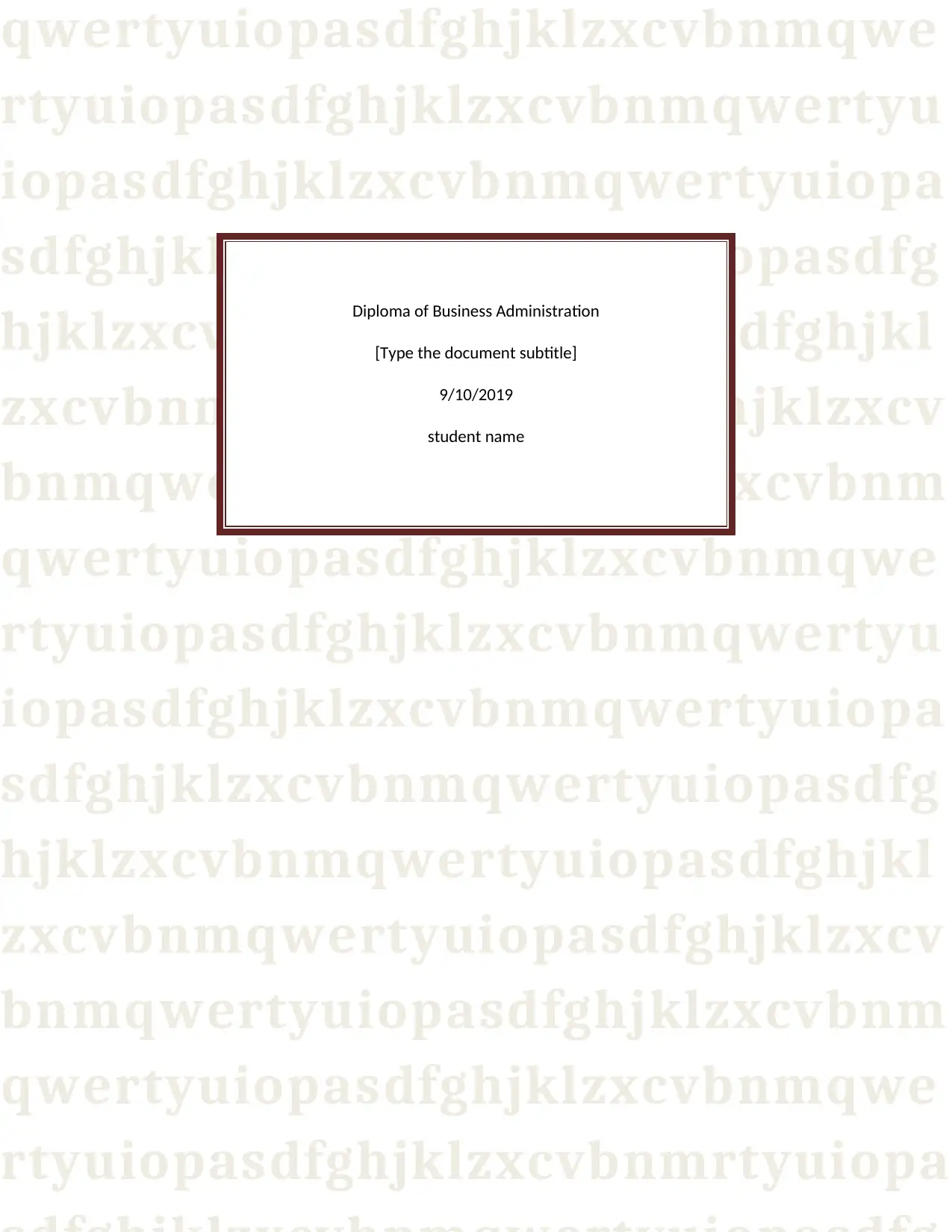
qwertyuiopasdfghjklzxcvbnmqwe
rtyuiopasdfghjklzxcvbnmqwertyu
iopasdfghjklzxcvbnmqwertyuiopa
sdfghjklzxcvbnmqwertyuiopasdfg
hjklzxcvbnmqwertyuiopasdfghjkl
zxcvbnmqwertyuiopasdfghjklzxcv
bnmqwertyuiopasdfghjklzxcvbnm
qwertyuiopasdfghjklzxcvbnmqwe
rtyuiopasdfghjklzxcvbnmqwertyu
iopasdfghjklzxcvbnmqwertyuiopa
sdfghjklzxcvbnmqwertyuiopasdfg
hjklzxcvbnmqwertyuiopasdfghjkl
zxcvbnmqwertyuiopasdfghjklzxcv
bnmqwertyuiopasdfghjklzxcvbnm
qwertyuiopasdfghjklzxcvbnmqwe
rtyuiopasdfghjklzxcvbnmrtyuiopa
Diploma of Business Administration
[Type the document subtitle]
9/10/2019
student name
rtyuiopasdfghjklzxcvbnmqwertyu
iopasdfghjklzxcvbnmqwertyuiopa
sdfghjklzxcvbnmqwertyuiopasdfg
hjklzxcvbnmqwertyuiopasdfghjkl
zxcvbnmqwertyuiopasdfghjklzxcv
bnmqwertyuiopasdfghjklzxcvbnm
qwertyuiopasdfghjklzxcvbnmqwe
rtyuiopasdfghjklzxcvbnmqwertyu
iopasdfghjklzxcvbnmqwertyuiopa
sdfghjklzxcvbnmqwertyuiopasdfg
hjklzxcvbnmqwertyuiopasdfghjkl
zxcvbnmqwertyuiopasdfghjklzxcv
bnmqwertyuiopasdfghjklzxcvbnm
qwertyuiopasdfghjklzxcvbnmqwe
rtyuiopasdfghjklzxcvbnmrtyuiopa
Diploma of Business Administration
[Type the document subtitle]
9/10/2019
student name
Paraphrase This Document
Need a fresh take? Get an instant paraphrase of this document with our AI Paraphraser
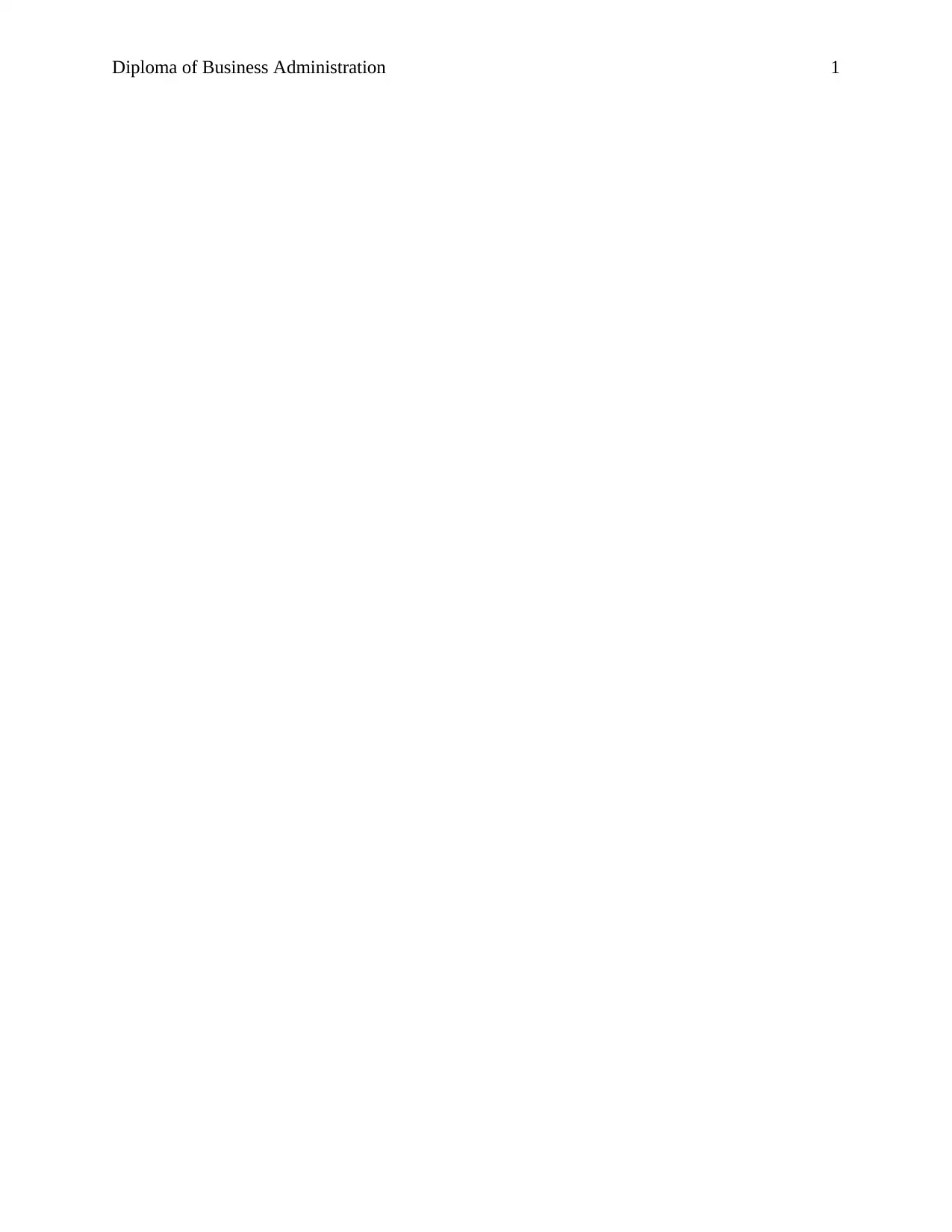
Diploma of Business Administration 1
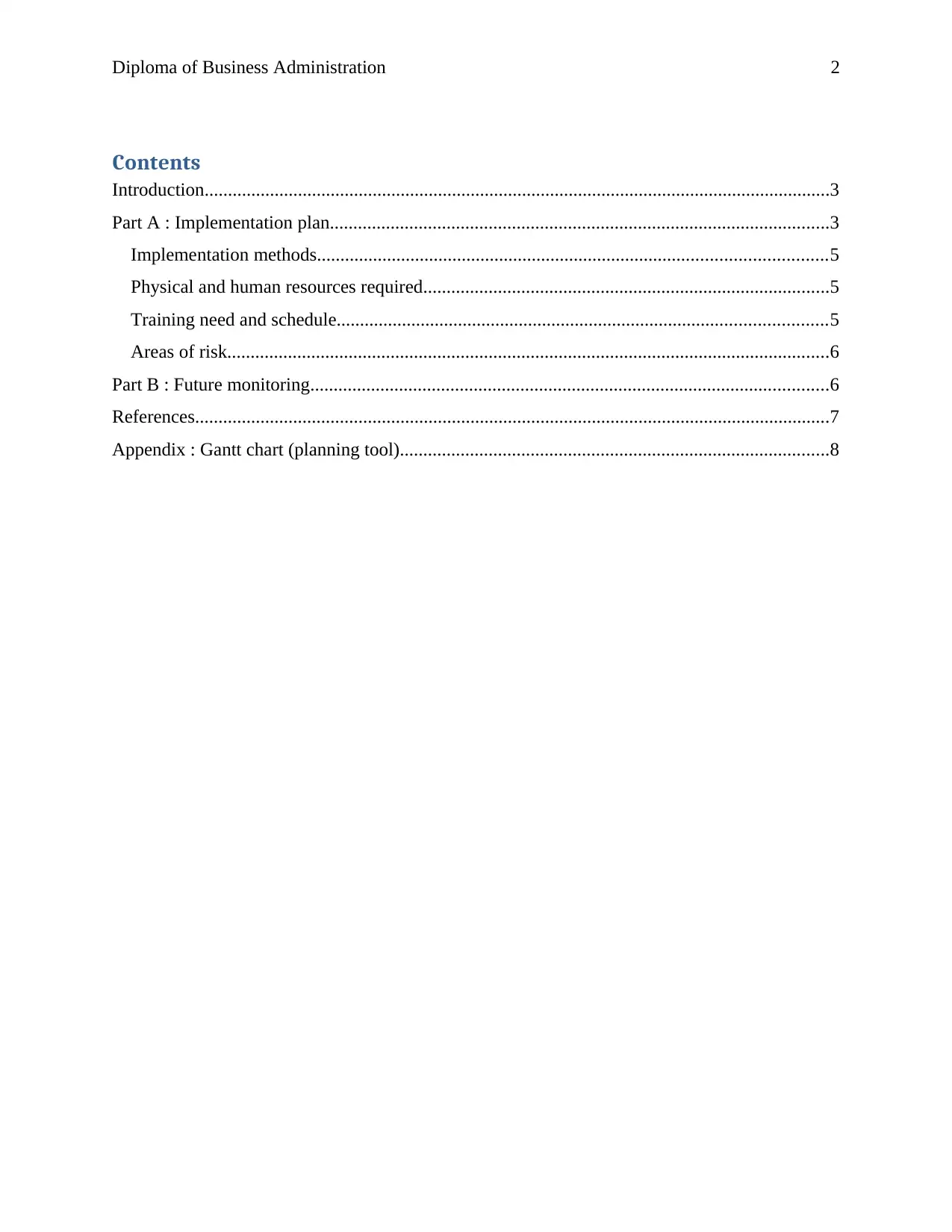
Diploma of Business Administration 2
Contents
Introduction......................................................................................................................................3
Part A : Implementation plan...........................................................................................................3
Implementation methods.............................................................................................................5
Physical and human resources required.......................................................................................5
Training need and schedule.........................................................................................................5
Areas of risk.................................................................................................................................6
Part B : Future monitoring...............................................................................................................6
References........................................................................................................................................7
Appendix : Gantt chart (planning tool)............................................................................................8
Contents
Introduction......................................................................................................................................3
Part A : Implementation plan...........................................................................................................3
Implementation methods.............................................................................................................5
Physical and human resources required.......................................................................................5
Training need and schedule.........................................................................................................5
Areas of risk.................................................................................................................................6
Part B : Future monitoring...............................................................................................................6
References........................................................................................................................................7
Appendix : Gantt chart (planning tool)............................................................................................8
⊘ This is a preview!⊘
Do you want full access?
Subscribe today to unlock all pages.

Trusted by 1+ million students worldwide
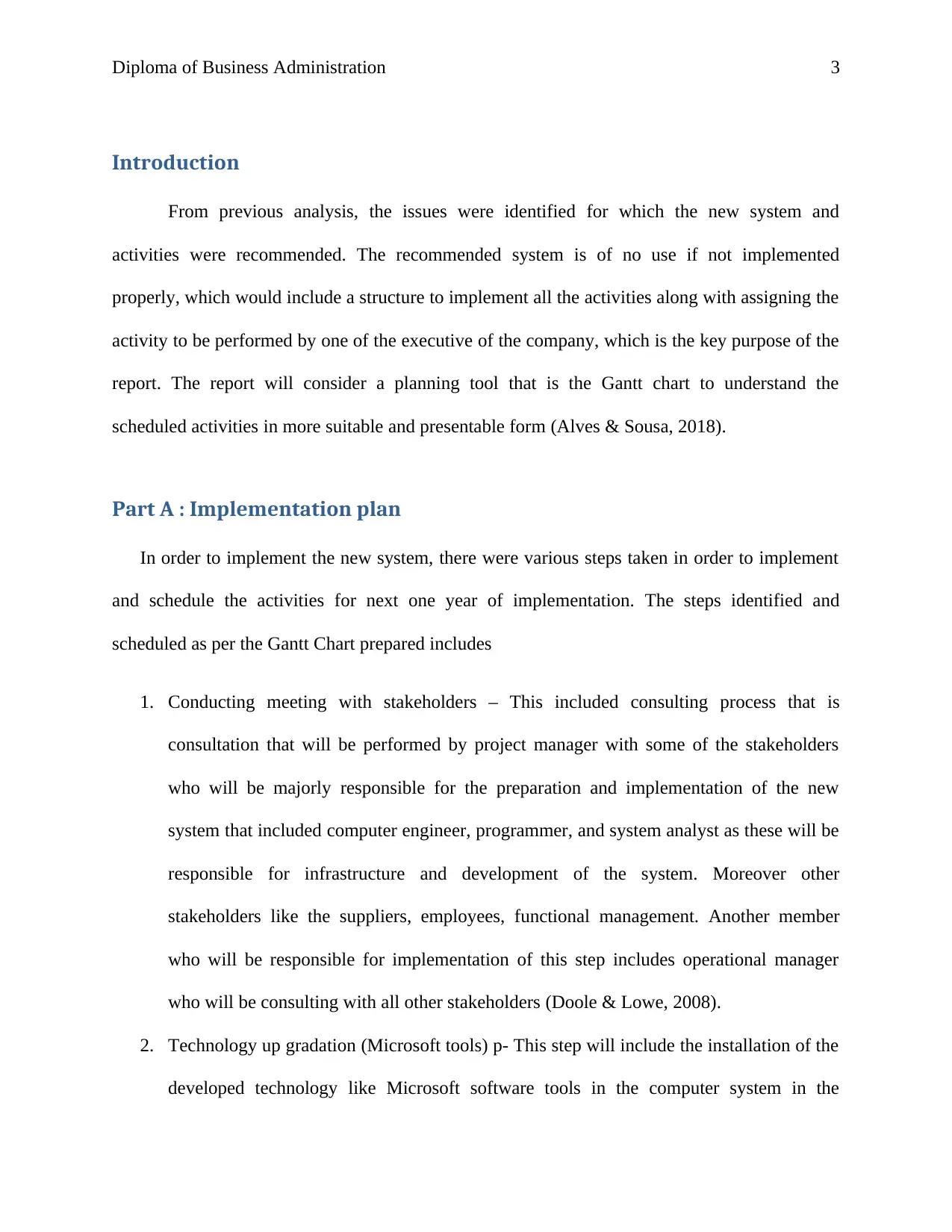
Diploma of Business Administration 3
Introduction
From previous analysis, the issues were identified for which the new system and
activities were recommended. The recommended system is of no use if not implemented
properly, which would include a structure to implement all the activities along with assigning the
activity to be performed by one of the executive of the company, which is the key purpose of the
report. The report will consider a planning tool that is the Gantt chart to understand the
scheduled activities in more suitable and presentable form (Alves & Sousa, 2018).
Part A : Implementation plan
In order to implement the new system, there were various steps taken in order to implement
and schedule the activities for next one year of implementation. The steps identified and
scheduled as per the Gantt Chart prepared includes
1. Conducting meeting with stakeholders – This included consulting process that is
consultation that will be performed by project manager with some of the stakeholders
who will be majorly responsible for the preparation and implementation of the new
system that included computer engineer, programmer, and system analyst as these will be
responsible for infrastructure and development of the system. Moreover other
stakeholders like the suppliers, employees, functional management. Another member
who will be responsible for implementation of this step includes operational manager
who will be consulting with all other stakeholders (Doole & Lowe, 2008).
2. Technology up gradation (Microsoft tools) p- This step will include the installation of the
developed technology like Microsoft software tools in the computer system in the
Introduction
From previous analysis, the issues were identified for which the new system and
activities were recommended. The recommended system is of no use if not implemented
properly, which would include a structure to implement all the activities along with assigning the
activity to be performed by one of the executive of the company, which is the key purpose of the
report. The report will consider a planning tool that is the Gantt chart to understand the
scheduled activities in more suitable and presentable form (Alves & Sousa, 2018).
Part A : Implementation plan
In order to implement the new system, there were various steps taken in order to implement
and schedule the activities for next one year of implementation. The steps identified and
scheduled as per the Gantt Chart prepared includes
1. Conducting meeting with stakeholders – This included consulting process that is
consultation that will be performed by project manager with some of the stakeholders
who will be majorly responsible for the preparation and implementation of the new
system that included computer engineer, programmer, and system analyst as these will be
responsible for infrastructure and development of the system. Moreover other
stakeholders like the suppliers, employees, functional management. Another member
who will be responsible for implementation of this step includes operational manager
who will be consulting with all other stakeholders (Doole & Lowe, 2008).
2. Technology up gradation (Microsoft tools) p- This step will include the installation of the
developed technology like Microsoft software tools in the computer system in the
Paraphrase This Document
Need a fresh take? Get an instant paraphrase of this document with our AI Paraphraser
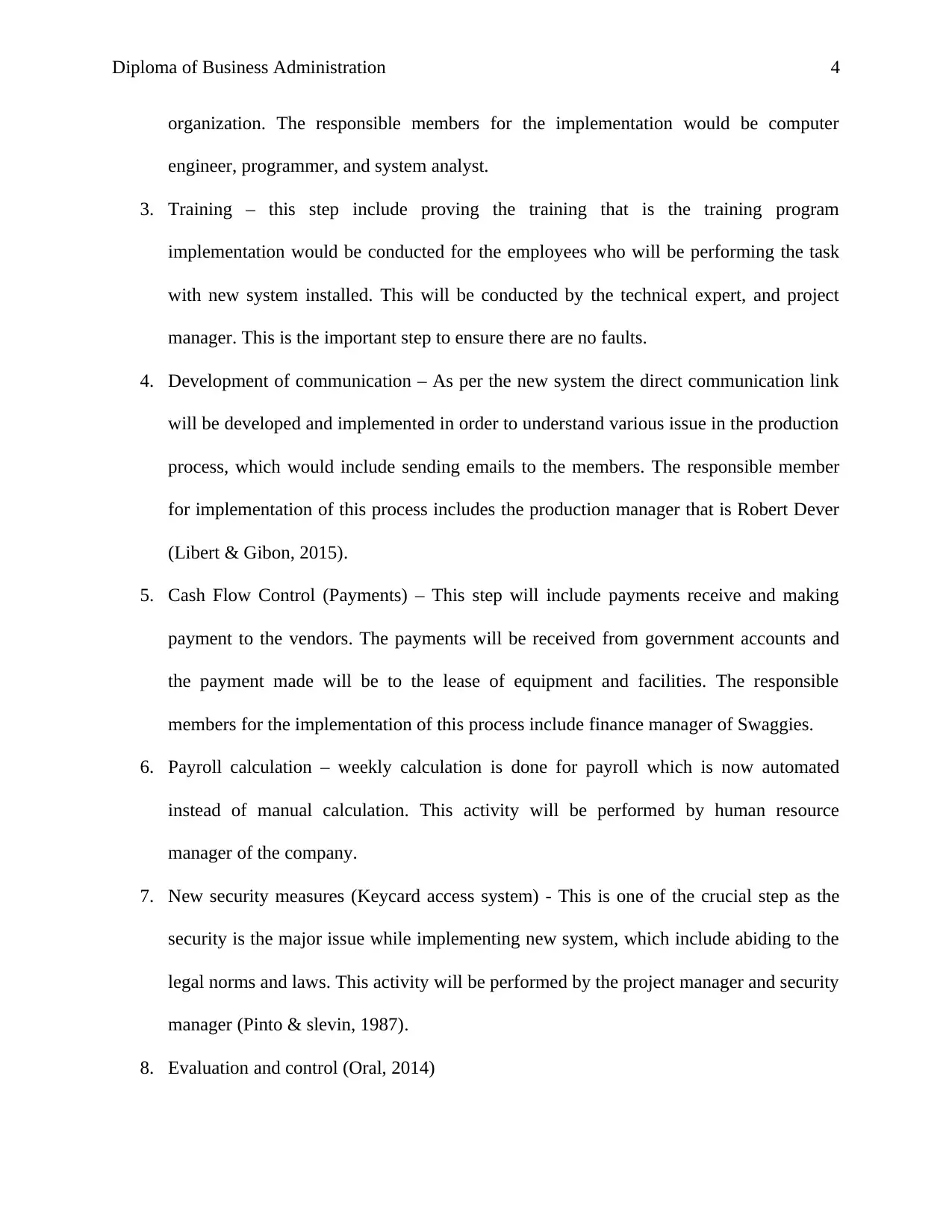
Diploma of Business Administration 4
organization. The responsible members for the implementation would be computer
engineer, programmer, and system analyst.
3. Training – this step include proving the training that is the training program
implementation would be conducted for the employees who will be performing the task
with new system installed. This will be conducted by the technical expert, and project
manager. This is the important step to ensure there are no faults.
4. Development of communication – As per the new system the direct communication link
will be developed and implemented in order to understand various issue in the production
process, which would include sending emails to the members. The responsible member
for implementation of this process includes the production manager that is Robert Dever
(Libert & Gibon, 2015).
5. Cash Flow Control (Payments) – This step will include payments receive and making
payment to the vendors. The payments will be received from government accounts and
the payment made will be to the lease of equipment and facilities. The responsible
members for the implementation of this process include finance manager of Swaggies.
6. Payroll calculation – weekly calculation is done for payroll which is now automated
instead of manual calculation. This activity will be performed by human resource
manager of the company.
7. New security measures (Keycard access system) - This is one of the crucial step as the
security is the major issue while implementing new system, which include abiding to the
legal norms and laws. This activity will be performed by the project manager and security
manager (Pinto & slevin, 1987).
8. Evaluation and control (Oral, 2014)
organization. The responsible members for the implementation would be computer
engineer, programmer, and system analyst.
3. Training – this step include proving the training that is the training program
implementation would be conducted for the employees who will be performing the task
with new system installed. This will be conducted by the technical expert, and project
manager. This is the important step to ensure there are no faults.
4. Development of communication – As per the new system the direct communication link
will be developed and implemented in order to understand various issue in the production
process, which would include sending emails to the members. The responsible member
for implementation of this process includes the production manager that is Robert Dever
(Libert & Gibon, 2015).
5. Cash Flow Control (Payments) – This step will include payments receive and making
payment to the vendors. The payments will be received from government accounts and
the payment made will be to the lease of equipment and facilities. The responsible
members for the implementation of this process include finance manager of Swaggies.
6. Payroll calculation – weekly calculation is done for payroll which is now automated
instead of manual calculation. This activity will be performed by human resource
manager of the company.
7. New security measures (Keycard access system) - This is one of the crucial step as the
security is the major issue while implementing new system, which include abiding to the
legal norms and laws. This activity will be performed by the project manager and security
manager (Pinto & slevin, 1987).
8. Evaluation and control (Oral, 2014)
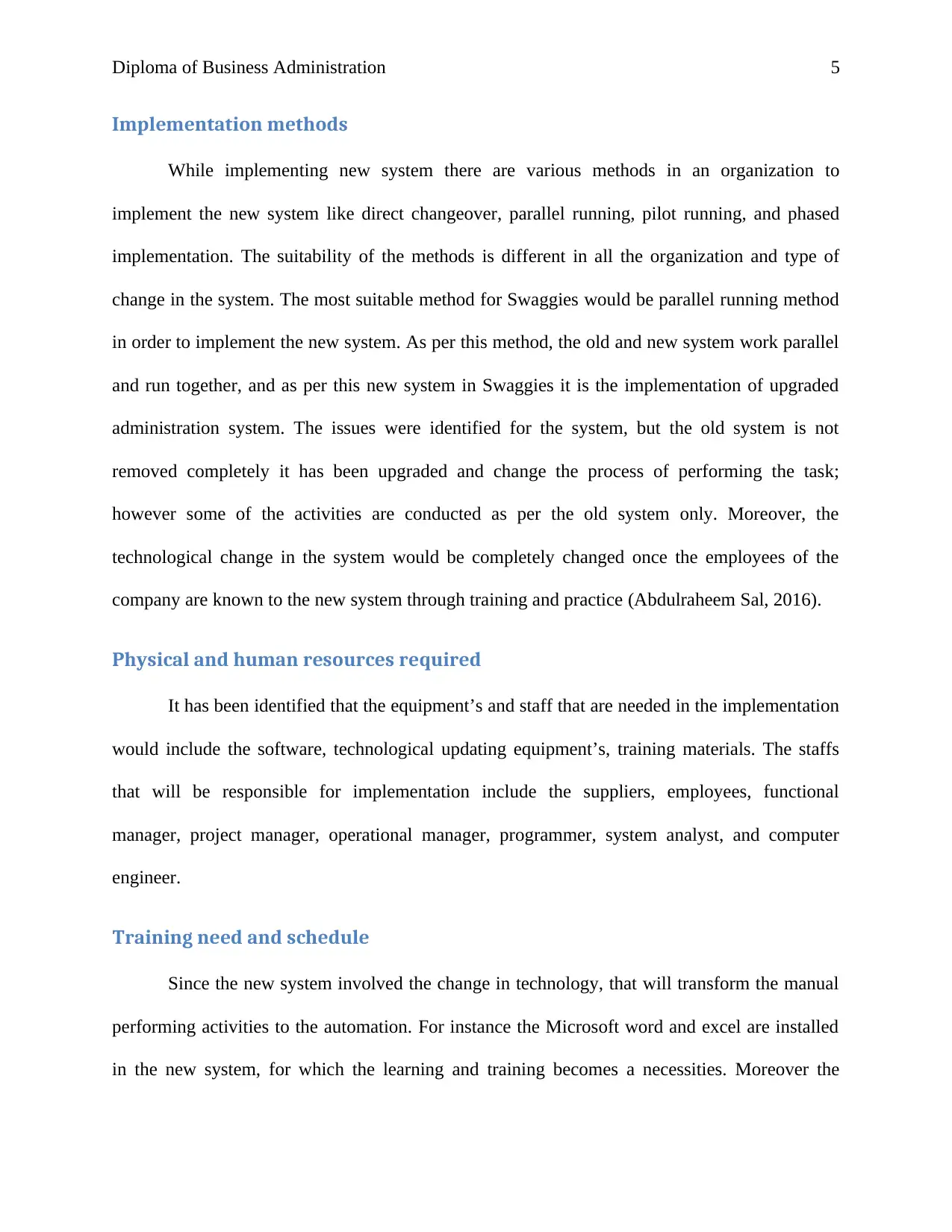
Diploma of Business Administration 5
Implementation methods
While implementing new system there are various methods in an organization to
implement the new system like direct changeover, parallel running, pilot running, and phased
implementation. The suitability of the methods is different in all the organization and type of
change in the system. The most suitable method for Swaggies would be parallel running method
in order to implement the new system. As per this method, the old and new system work parallel
and run together, and as per this new system in Swaggies it is the implementation of upgraded
administration system. The issues were identified for the system, but the old system is not
removed completely it has been upgraded and change the process of performing the task;
however some of the activities are conducted as per the old system only. Moreover, the
technological change in the system would be completely changed once the employees of the
company are known to the new system through training and practice (Abdulraheem Sal, 2016).
Physical and human resources required
It has been identified that the equipment’s and staff that are needed in the implementation
would include the software, technological updating equipment’s, training materials. The staffs
that will be responsible for implementation include the suppliers, employees, functional
manager, project manager, operational manager, programmer, system analyst, and computer
engineer.
Training need and schedule
Since the new system involved the change in technology, that will transform the manual
performing activities to the automation. For instance the Microsoft word and excel are installed
in the new system, for which the learning and training becomes a necessities. Moreover the
Implementation methods
While implementing new system there are various methods in an organization to
implement the new system like direct changeover, parallel running, pilot running, and phased
implementation. The suitability of the methods is different in all the organization and type of
change in the system. The most suitable method for Swaggies would be parallel running method
in order to implement the new system. As per this method, the old and new system work parallel
and run together, and as per this new system in Swaggies it is the implementation of upgraded
administration system. The issues were identified for the system, but the old system is not
removed completely it has been upgraded and change the process of performing the task;
however some of the activities are conducted as per the old system only. Moreover, the
technological change in the system would be completely changed once the employees of the
company are known to the new system through training and practice (Abdulraheem Sal, 2016).
Physical and human resources required
It has been identified that the equipment’s and staff that are needed in the implementation
would include the software, technological updating equipment’s, training materials. The staffs
that will be responsible for implementation include the suppliers, employees, functional
manager, project manager, operational manager, programmer, system analyst, and computer
engineer.
Training need and schedule
Since the new system involved the change in technology, that will transform the manual
performing activities to the automation. For instance the Microsoft word and excel are installed
in the new system, for which the learning and training becomes a necessities. Moreover the
⊘ This is a preview!⊘
Do you want full access?
Subscribe today to unlock all pages.

Trusted by 1+ million students worldwide
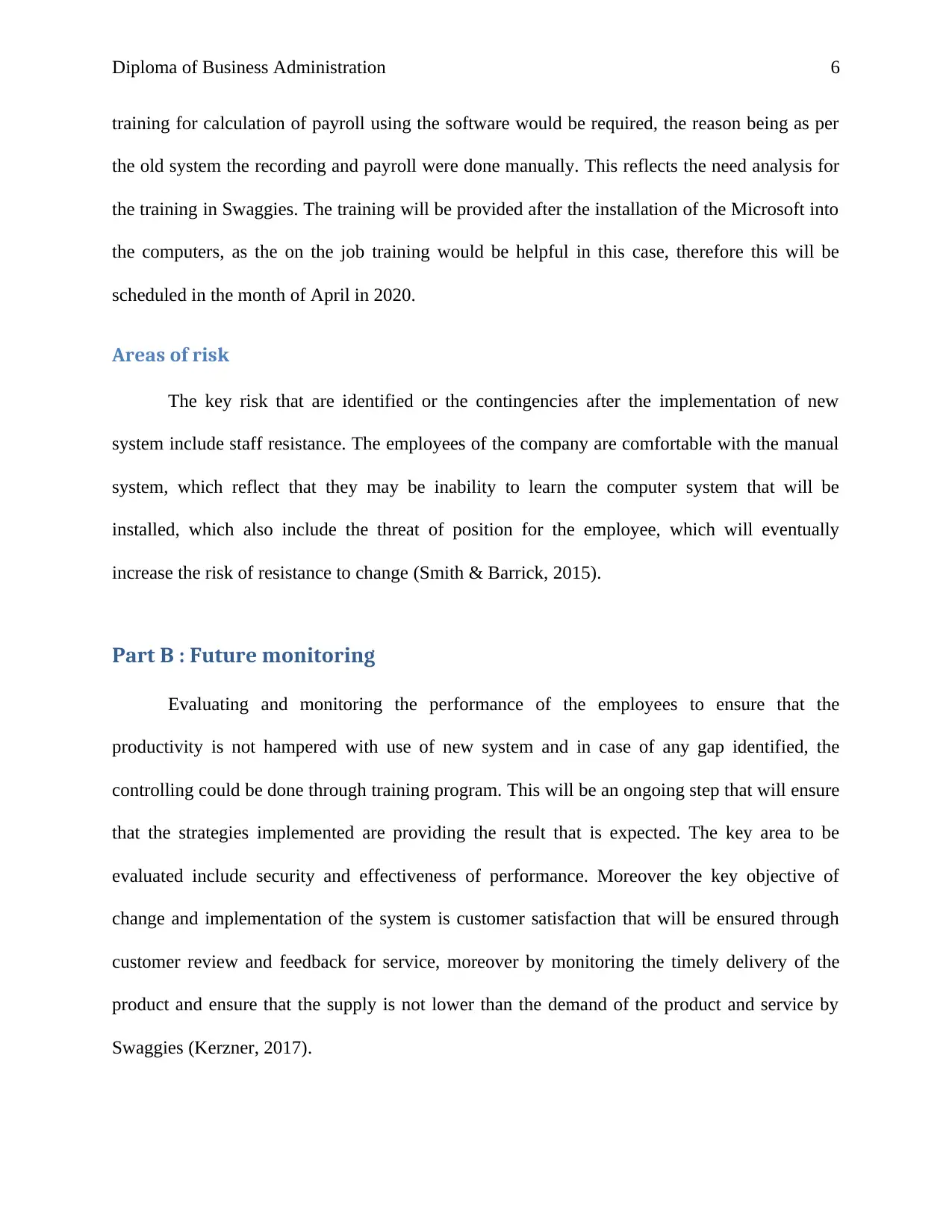
Diploma of Business Administration 6
training for calculation of payroll using the software would be required, the reason being as per
the old system the recording and payroll were done manually. This reflects the need analysis for
the training in Swaggies. The training will be provided after the installation of the Microsoft into
the computers, as the on the job training would be helpful in this case, therefore this will be
scheduled in the month of April in 2020.
Areas of risk
The key risk that are identified or the contingencies after the implementation of new
system include staff resistance. The employees of the company are comfortable with the manual
system, which reflect that they may be inability to learn the computer system that will be
installed, which also include the threat of position for the employee, which will eventually
increase the risk of resistance to change (Smith & Barrick, 2015).
Part B : Future monitoring
Evaluating and monitoring the performance of the employees to ensure that the
productivity is not hampered with use of new system and in case of any gap identified, the
controlling could be done through training program. This will be an ongoing step that will ensure
that the strategies implemented are providing the result that is expected. The key area to be
evaluated include security and effectiveness of performance. Moreover the key objective of
change and implementation of the system is customer satisfaction that will be ensured through
customer review and feedback for service, moreover by monitoring the timely delivery of the
product and ensure that the supply is not lower than the demand of the product and service by
Swaggies (Kerzner, 2017).
training for calculation of payroll using the software would be required, the reason being as per
the old system the recording and payroll were done manually. This reflects the need analysis for
the training in Swaggies. The training will be provided after the installation of the Microsoft into
the computers, as the on the job training would be helpful in this case, therefore this will be
scheduled in the month of April in 2020.
Areas of risk
The key risk that are identified or the contingencies after the implementation of new
system include staff resistance. The employees of the company are comfortable with the manual
system, which reflect that they may be inability to learn the computer system that will be
installed, which also include the threat of position for the employee, which will eventually
increase the risk of resistance to change (Smith & Barrick, 2015).
Part B : Future monitoring
Evaluating and monitoring the performance of the employees to ensure that the
productivity is not hampered with use of new system and in case of any gap identified, the
controlling could be done through training program. This will be an ongoing step that will ensure
that the strategies implemented are providing the result that is expected. The key area to be
evaluated include security and effectiveness of performance. Moreover the key objective of
change and implementation of the system is customer satisfaction that will be ensured through
customer review and feedback for service, moreover by monitoring the timely delivery of the
product and ensure that the supply is not lower than the demand of the product and service by
Swaggies (Kerzner, 2017).
Paraphrase This Document
Need a fresh take? Get an instant paraphrase of this document with our AI Paraphraser
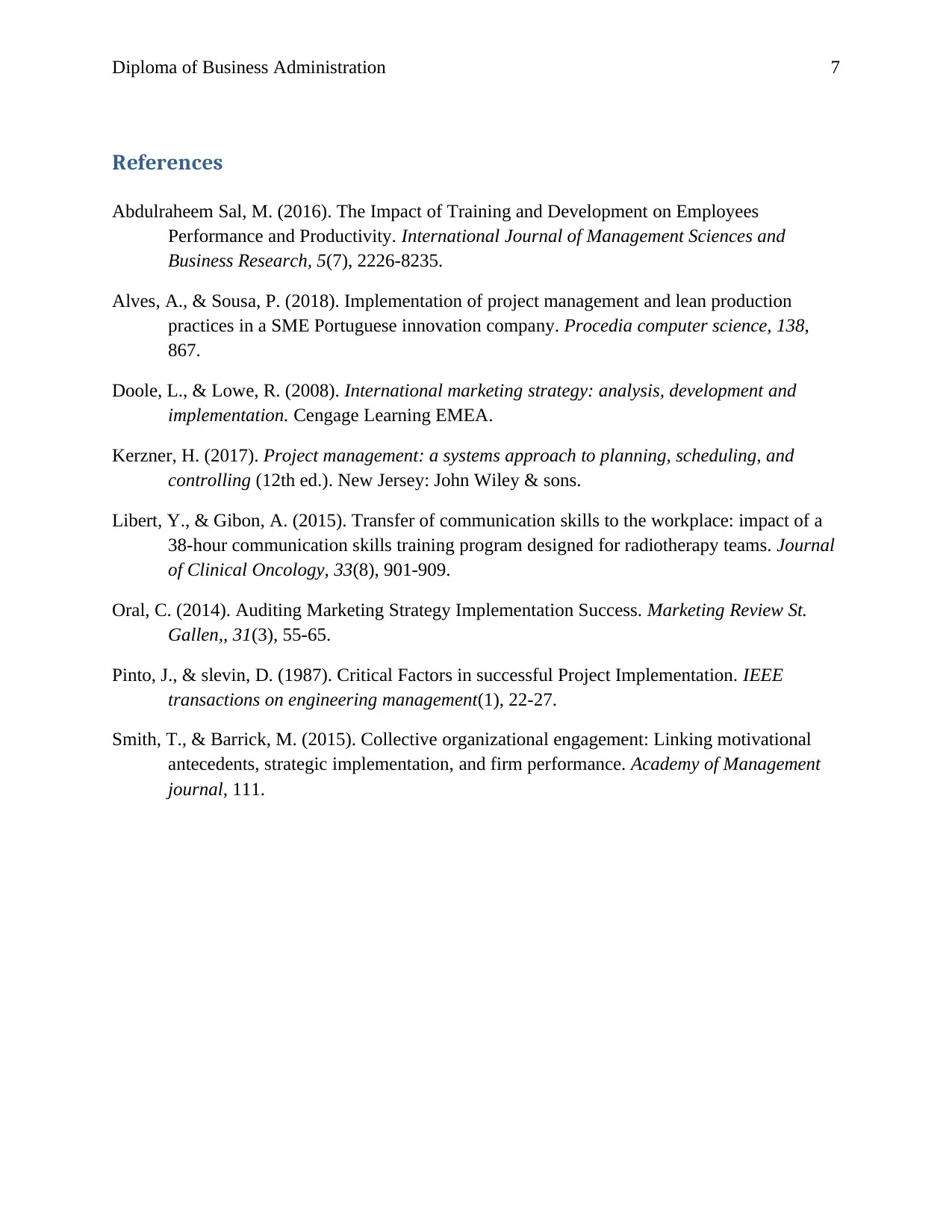
Diploma of Business Administration 7
References
Abdulraheem Sal, M. (2016). The Impact of Training and Development on Employees
Performance and Productivity. International Journal of Management Sciences and
Business Research, 5(7), 2226-8235.
Alves, A., & Sousa, P. (2018). Implementation of project management and lean production
practices in a SME Portuguese innovation company. Procedia computer science, 138,
867.
Doole, L., & Lowe, R. (2008). International marketing strategy: analysis, development and
implementation. Cengage Learning EMEA.
Kerzner, H. (2017). Project management: a systems approach to planning, scheduling, and
controlling (12th ed.). New Jersey: John Wiley & sons.
Libert, Y., & Gibon, A. (2015). Transfer of communication skills to the workplace: impact of a
38-hour communication skills training program designed for radiotherapy teams. Journal
of Clinical Oncology, 33(8), 901-909.
Oral, C. (2014). Auditing Marketing Strategy Implementation Success. Marketing Review St.
Gallen,, 31(3), 55-65.
Pinto, J., & slevin, D. (1987). Critical Factors in successful Project Implementation. IEEE
transactions on engineering management(1), 22-27.
Smith, T., & Barrick, M. (2015). Collective organizational engagement: Linking motivational
antecedents, strategic implementation, and firm performance. Academy of Management
journal, 111.
References
Abdulraheem Sal, M. (2016). The Impact of Training and Development on Employees
Performance and Productivity. International Journal of Management Sciences and
Business Research, 5(7), 2226-8235.
Alves, A., & Sousa, P. (2018). Implementation of project management and lean production
practices in a SME Portuguese innovation company. Procedia computer science, 138,
867.
Doole, L., & Lowe, R. (2008). International marketing strategy: analysis, development and
implementation. Cengage Learning EMEA.
Kerzner, H. (2017). Project management: a systems approach to planning, scheduling, and
controlling (12th ed.). New Jersey: John Wiley & sons.
Libert, Y., & Gibon, A. (2015). Transfer of communication skills to the workplace: impact of a
38-hour communication skills training program designed for radiotherapy teams. Journal
of Clinical Oncology, 33(8), 901-909.
Oral, C. (2014). Auditing Marketing Strategy Implementation Success. Marketing Review St.
Gallen,, 31(3), 55-65.
Pinto, J., & slevin, D. (1987). Critical Factors in successful Project Implementation. IEEE
transactions on engineering management(1), 22-27.
Smith, T., & Barrick, M. (2015). Collective organizational engagement: Linking motivational
antecedents, strategic implementation, and firm performance. Academy of Management
journal, 111.
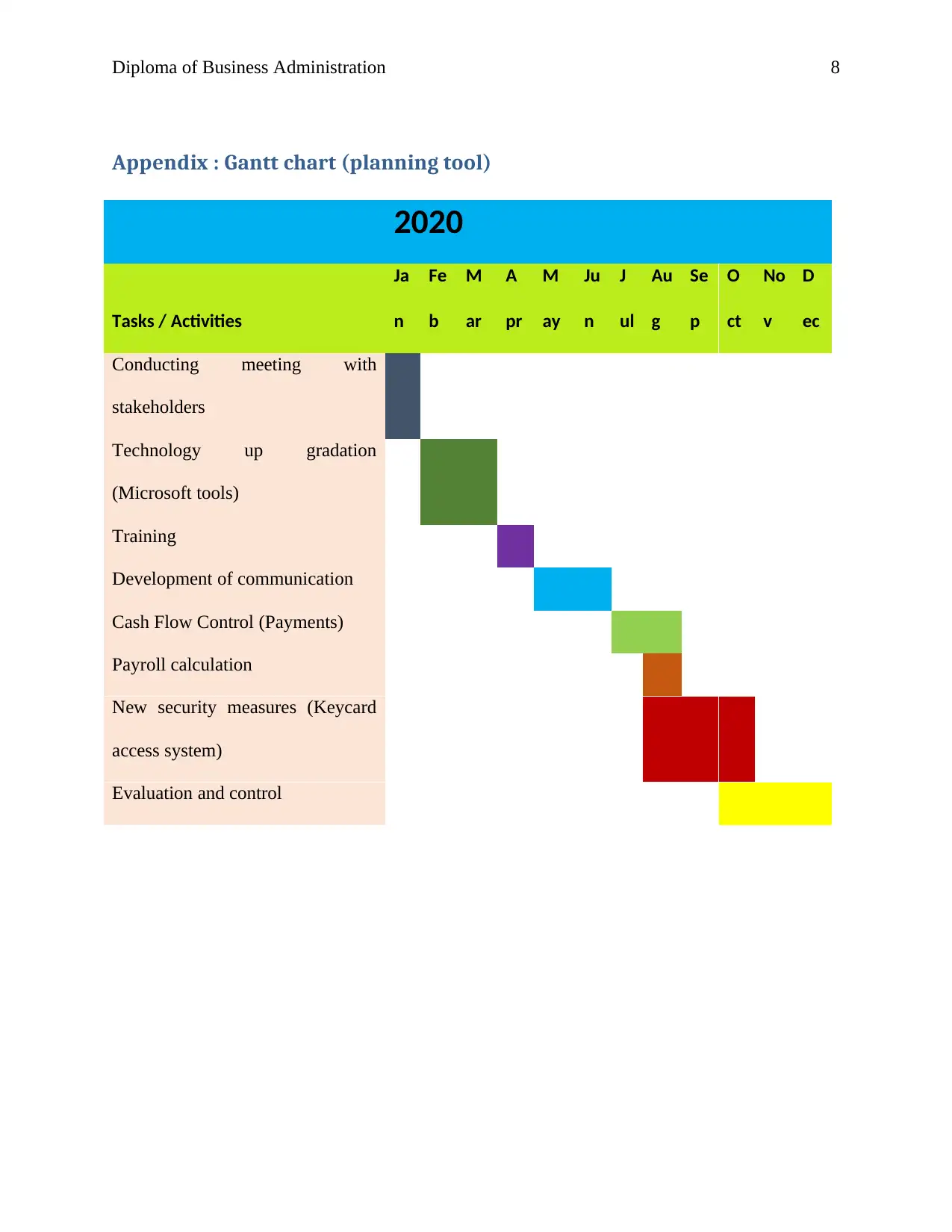
Diploma of Business Administration 8
Appendix : Gantt chart (planning tool)
2020
Tasks / Activities
Ja
n
Fe
b
M
ar
A
pr
M
ay
Ju
n
J
ul
Au
g
Se
p
O
ct
No
v
D
ec
Conducting meeting with
stakeholders
Technology up gradation
(Microsoft tools)
Training
Development of communication
Cash Flow Control (Payments)
Payroll calculation
New security measures (Keycard
access system)
Evaluation and control
Appendix : Gantt chart (planning tool)
2020
Tasks / Activities
Ja
n
Fe
b
M
ar
A
pr
M
ay
Ju
n
J
ul
Au
g
Se
p
O
ct
No
v
D
ec
Conducting meeting with
stakeholders
Technology up gradation
(Microsoft tools)
Training
Development of communication
Cash Flow Control (Payments)
Payroll calculation
New security measures (Keycard
access system)
Evaluation and control
⊘ This is a preview!⊘
Do you want full access?
Subscribe today to unlock all pages.

Trusted by 1+ million students worldwide
1 out of 9
Related Documents
Your All-in-One AI-Powered Toolkit for Academic Success.
+13062052269
info@desklib.com
Available 24*7 on WhatsApp / Email
![[object Object]](/_next/static/media/star-bottom.7253800d.svg)
Unlock your academic potential
Copyright © 2020–2025 A2Z Services. All Rights Reserved. Developed and managed by ZUCOL.





